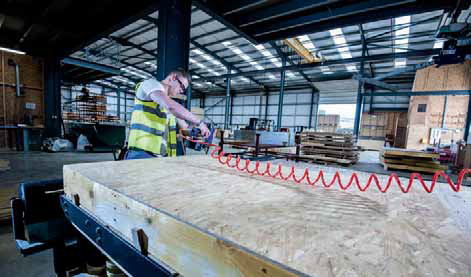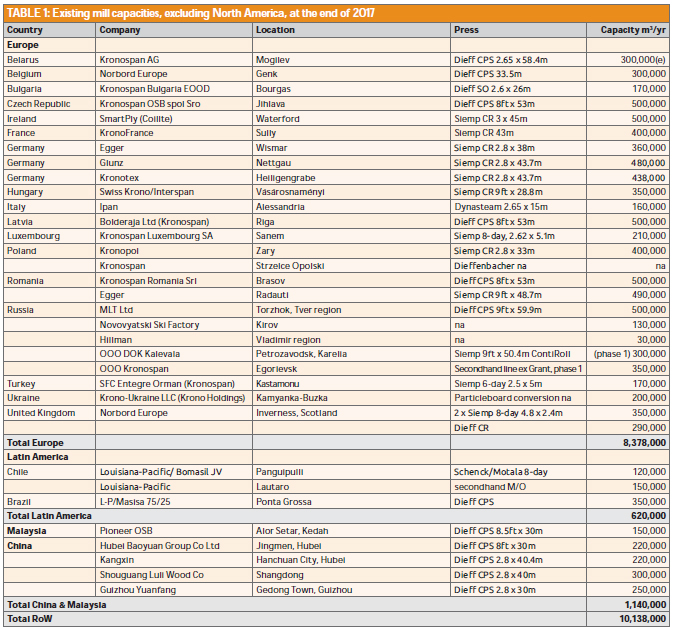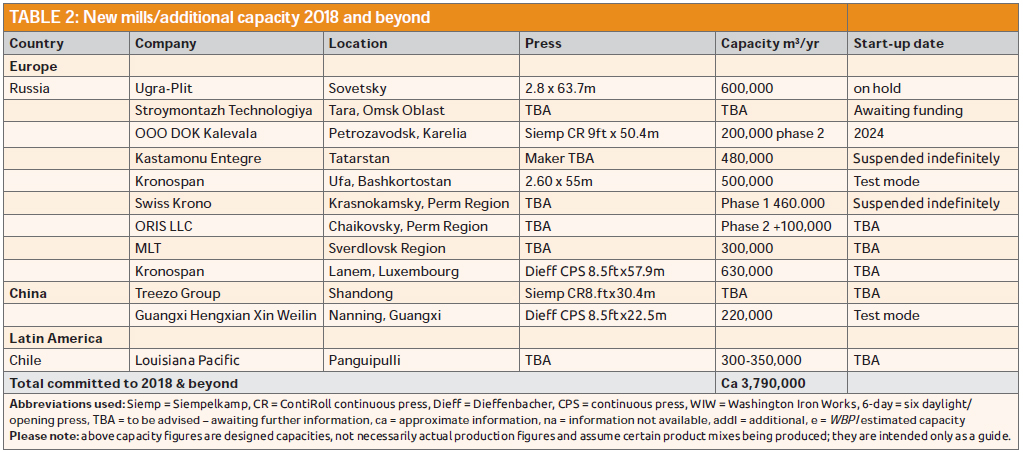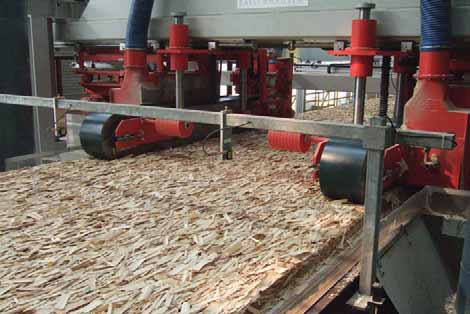Production capacity continues to grow
2 May 2018New mills are coming into production as economic and construction growth continues. Keren Fallwell reports
OSB production and demand in Europe have been rising consistently for several years now, giving manufacturers the confidence to invest in upgrades and new lines.
According to the European Panel Federation (EPF) 2016/2017 annual report, in 2016 OSB production in Europe increased by 6.9% to 5.4 million m3 (2015: 5 million m3). It has been steadily rising every year since 2013 but 2016 recorded the biggest growth.
European capacity also rose last year – by 490,000m3 to 6.5 million m3. This was the result of the commissioning of the new plant at Swiss Krono in Vásárosnamény in Hungary, completion of Norbord’s new line at Inverness, Scotland and investments at SmartPly in Waterford, Ireland, and Norbord in Genk, Belgium.
In its annual report, Norbord says that its European panel mills ran on full production schedules during 2017, producing at 99% of capacity – in line with the previous year. Shipments from its European mills increased by 5% on 2016.
The upbeat market was also reflected in orders for machinery. Among the 14 orders for new wood based panel plants placed with Dieffenbacher in 2017, four were from the OSB sector and all from Kronospan. One order was for a new, replacement forming line, press and finishing line for Kronospan’s factory in Sanem, Luxembourg, and the other three for OSB press extensions. Unconfirmed reports suggest that these are for continuous presses in operation at Kronospan’s eastern European mills in Riga, Latvia; Jihlava, Czech Republic; and Strzelce-Opolskie, Poland.
This year, Dieffenbacher is anticipating one of its busiest years on record across all panel types. It expects orders for two OSB plant projects in eastern Europe and Russia and another two from the Asian market.
Across Europe, demand for OSB is brisk, and strengthening, giving OSB manufacturers the confidence to make investments that give them additional capacity and the ability to make more value-added products.
“In Europe, OSB remains the fastest growing structural panel in terms of consumption growth,” said one manufacturer.
Much of this growth is down to OSB muscling in on what were traditionally plywood applications, and also construction activity is picking up as European economies stabilise.
In Russia, Modern Lumber Technology (MLT) has announced plans to build a second OSB mill. In July 2016 the company, one of the biggest producers of LVL in Europe with the Ultralam brand, commissioned a 500,000m3 capacity OSB mill in Torzhok, Tver Region, north-east of Moscow, to manufacture OSB3 and OSB4. The Taleon Arbor facility is Russia’s largest capacity OSB mill and, housing a 9ftx59.9m continuous press from Dieffenbacher, it is arguably one of the longest OSB presses in Europe.
Now MLT has signed a Memorandum of Understanding with the Sverdlovsk Region government for the “creation of high-tech woodworking production” in the Urals. The first phase of the timber production complex will be an OSB mill with an estimated capacity of 300,000m3.
According to market intelligence analyst Timetric, construction of phase 2 of Kalevala’s timber complex in Petrozavodsk, Karelia is due to start in the third quarter of this year. It’s scheduled for completion at the end of 2024. The US$37m investment will complement the existing line and increase the site’s capacity from 300,000m3 to 500,000m3.
The Stroymontazh Technologiya Group has plans for a 250,000m3 capacity OSB plant in the Tara district of Omsk. The mill was mooted in 2010 but put on hold in 2013 because of funding problems. Timetric reports that the owners are again looking for investors and, if they’re successful, construction will start in the second quarter of next year and be completed towards the end of 2022.
Kronospan is also boosting its OSB capacity. In Russia, the company is adding an OSB line to its particleboard mill in Ufa, Bashkortostan. The plant, which has a 500,000m3 annual capacity, is due to be commissioned in the third quarter of this year.
Meanwhile at Kronospan Luxembourg the continuous press replacing the existing multi-opening line is due to come on stream in autumn this year. The old line has been in operation since 1996 and was one of the first OSB production plants in western Europe.
Early last year the company also announced plans to invest around US$200m in expanding its two mills in Belarus. It produces particleboard, MDF and laminate flooring at Smorgon and OSB at Mogilev but it is not clear how the investment will be made.
In the UK there is still talk that Kronospan may install an OSB line at its factory in Chirk, Wales. The site currently produces MDF and particleboard. The investment rumours have circulated for some time and chairman Mike McKenna confirmed the company’s interest during a visit by the secretary of state for Wales in October last year.
Through Kronospan’s '2020 Vision' for the site it is investing £200m in updating its facilities over the next three years and Mr McKenna told the Shropshire Star newspaper that as part of that investment it would like to start producing OSB.
“It is increasingly important for building badly needed new homes and would in itself create 100 jobs at the Chirk site,” he said. The factory, which currently employs 350 people, has planning permission to construct a building to house a new wood preparation facility.
One industry contact said Kronospan had “been talking about it for a number of years” and would make the decision to build a new mill only if it was commercially viable.
“They still have significant issues around planning and fibre supply and that might lead to their having to shut an MDF line [in order to build a new mill],” he said.
If Kronospan were to install an OSB line at Chirk it would create a hat trick of state-of-the- art OSB production in the British Isles.
In 2016 SmartPly started up its new Siempelkamp ContiRoll continuous press at Waterford in Ireland. The 45m-long, 3m-wide press, described at the time by the company as the “most modern continuous OSB press in Europe”, replaced a 14-daylight multi opening Washington Iron Works press and raised production capacity from 350,000m3 a year to 500,000m3. It also enabled SmartPly to produce a greater range of panel widths and thicknesses; and to a consistent quality.
Norbord has now completed its £95m investment in a new OSB line at Inverness, Scotland, which produced its first board in September last year. The new facility puts Norbord in the lead as the biggest producer in the UK and Ireland. The Dieffenbacher continuous press, shipped from Ainsworth’s Grande Prairie mill in Alberta, Canada, where it had been installed but never used, gives Norbord a 290,000m3 increase in annual production capacity to 640,000m3. However, as president and CEO Peter Wijnbergen mentioned in Norbord’s recent annual report, the Inverness mill’s OSB output is not expected to increase markedly this year as production is shifted from the old lines to the new.
The line has been constructed on a greenfield site adjacent to the building housing the two eight-daylight Siempelkamp press lines the new facility is replacing.
OSB production is also expanding in China, with Siempelkamp and Dieffenbacher both receiving orders for new lines.
In September 2017, Treezo Group placed an order with Siempelkamp for a complete OSB plant with an 8.5ftx30.4m ContiRoll press. Treezo already produces plywood and blockboard and flooring solutions. The OSB plant will be built in Shandong and will produce laminated OSB for furniture manufacturing. Dieffenbacher has supplied a new line to Guangxi Hengxian Xin Weilin Panel Industry.
The contract includes an 8.5ftx22.5m continuous CPS press and gluing, the forming station and final assembly, extraction system and plant control and automation.
Construction was due to start in November last year and the first board is expected to come off the line in the second quarter of this year. Annual capacity is said to be 220,000m3.
Financial Growth
This buoyant OSB market is reflected in the growth reported in manufacturers’ financial results, which may have been even more positive if not for the impact of higher resin costs last year.
For Norbord, 2017 was a record year with full-year adjusted EBITDA of US$672m – a 75% improvement on 2016. It attributes the record earnings largely to strong demand growth for OSB, especially in the UK and Germany.
“Our success last year was a function of solid operational performance and ongoing growth in OSB demand resulting in strong markets in both North America and Europe,” said Peter Wijnbergen.
He also highlighted the fact that OSB was encroaching on plywood’s market. In Europe, the strong price momentum seen in all panel products across Norbord’s core markets was supported by “ongoing demand growth and currency-aided substitution of OSB for plywood, which offset higher input costs, particularly for resin”.
“OSB substitution continues to accelerate in Europe, with its share of the structural panel market increasing from approximately 30% a decade ago to almost 50% today,” said Mr Wijnbergen.
Building on its record year in 2017, Norbord expects growth in Europe to continue this year. “We expect our European business to have an excellent year,” said the CEO. “While production from our expanded Inverness mill will not increase markedly from 2017 as we shift from the old lines to the new, we believe we will see further price momentum in 2018.
“Looking ahead to 2019 and beyond, the additional capacity at Inverness will position us to benefit from ongoing demand growth and the trend of OSB substitution for plywood.” In its half-year results for 2017/18 Egger’s Building Products division recorded a 9.2% increase in turnover in a market affected by raw material costs and availability issues. Sales of OSB increased, with the largest growth recorded in eastern Europe. Egger predicts strong growth in the second half of its financial year.
Krono Swiss has also reported positive financial results, with sales for the year ending September 30, 2017 up 4% to €1.56bn. Difficulties with the supply and quality of PMDI, and the resulting reduction in the availability of OSB, prevented sales rising further, the company said.
Managing director Uwe Jöst said PMDI deliveries had now been secured, but the purchase price was high.
He said European demand for OSB was very high and outpacing supply.
“Primarily the strong demand for OSB is from the construction sector,” said Mr Jöst. “Of course the booming overall economic situation also increases demand in other sectors, such as the packaging industry.”
Another European manufacturer said OSB demand started to strengthen in the second half of last year and he expected it to continue for the foreseeable future.
“The majority of European manufacturers are faced with huge order files and this gives us a positive perspective for 2018 at least,” he said.
Demand has had a positive effect on prices which follows the increases manufacturers imposed last year in response to higher resin costs.
“We are now perhaps at a stage where costs and prices are more or less balanced,” the manufacturer said. He added, however, that no-one could predict the path that resin costs would take this year.
In Europe, raw material was in tight supply because of strong demand for wood products; and for pulp and paper. “Competition for raw materials is quite heavy and this has already had an impact on costs,” said a manufacturer.
He added that he had no problems sourcing the material, but competing demand was pushing out lead times. In the UK, the tight raw material supply is a talking point for all timber sectors.
Competition for supply has intensified as private forest owners hold out for higher prices before they bring timber to the market.
Outside Europe, Louisiana-Pacific has also had positive returns from its OSB mills. In its latest financial results the company reported sales and revenue growth in South America where it has OSB mills in Chile and Brazil. In the fourth quarter of 2017 the South American segment reported net sales of US$41m, up 20% from the fourth quarter of 2016.
Operating income was US$8m compared with US$2m in the fourth quarter of 2016. For the full year, South America reported a 13% increase in sales to US$155m, and operating income of US$24m, up from US$17m for the corresponding period in 2016.
Strengthening economies across Europe, combined with housing shortages, mean demand for OSB will continue to rise for the foreseeable future.
According to Eurostat, the statistical office of the European Union, in December seasonally adjusted production in the construction sector in the eurozone increased by 0.1% compared with November, and by 0.6% in the EU28. Average production in construction for the whole of 2017 was 2.4% above that of 2016 in the eurozone and 3.5% higher in the EU28.
In 2017, UK construction companies had their best year in a decade for starting work on new homes and the outlook for 2018 is positive, according to the National House- Building Council.
Persimmon, the UK’s second largest housebuilder, reported a 25% increase in pre-tax profits for 2017, buoyed by demand for new housing. Completions rose 6% to 16,043. Chief executive Jeff Fairburn said the long-term unfulfilled demand for housing meant the fundamentals of the UK market remained strong but the short term did present some uncertainties.
“While conditions in the new-build housing market remain supportive, the negotiations associated with the UK’s exit from the EU, including both the transitional arrangements and the terms of the longer-term relationship, together with the nature of the UK’s trading relationships with its other global partners, present key uncertainties that will have a substantial influence on market outcomes.” National housebuilder Taylor Wimpey also reported a strong 2017, with nearly 15,000 homes completed, and entered 2018 with a strong order book.
“We have been encouraged by early trading patterns at the start to the year and despite some wider macro-economic uncertainty, consumer confidence remains robust and market fundamentals are solid,” chief executive Peter Redfern said in the company’s annual report.
One OSB manufacturer said demand was “holding up extremely well” in the UK although some key customer industries were still under par. Construction, however, would no doubt gather pace after Easter, which traditionally marks the start of the UK’s building season.
Supply and demand in the UK are considered to be “in close balance” but manufacturers have been on allocation for the past 12 months and this is expected to continue. It is largely the result of European manufacturers withdrawing from the UK market because of the sterling/euro exchange rate in the wake of the EU referendum.
OSB prices in Europe have been rising steadily over the past year in response to supply and cost issues, particularly the cost of resins, and in the UK they’ve risen by around 50% over the past 16 months. Plywood, however, has also increased in price.
“Although the price of OSB has increased by an unprecedented amount it remains the cheapest certified structural panel in the European market by at least 10-15%,” said a manufacturer.
UK manufacturers are no doubt buoyed by a fresh commitment by the UK government for 300,000 homes a year to be built to tackle the housing shortage. In a speech in March, UK prime minister Theresa May cited the nation’s housing crisis as one of the biggest barriers to social mobility and announced the government was streamlining planning processes to ease the way for more homes to be built.
Housebuilders and construction materials suppliers will be aware, however, that similar promises made by previous governments have come to nothing.
That said, the dire need for more housing is recognised and hand in hand with this is the acknowledgement that prefabricated construction, which can make good use of OSB, is best suited to meet that need.
A report by the London Assembly Planning Committee last year said that off-site manufacturing could play an important role in delivering the 50,000 new homes a year that London needs. The report, Designed, sealed, delivered: The contribution of offsite manufactured homes to solving London’s housing crisis, urged the London mayor to develop a manufactured housing design code to drive a more standardised approach. It also called for funding for off-site manufacturing.
Value Added Products
In tandem with this is the increasing demand for building products which meet requirements for enhanced airtightness and flame retardancy and European OSB manufacturers are responding.
“Most manufacturers are focusing on how to deliver different solutions to meet the needs of specifiers and architects, developing new products for new solutions rather than being sucked into a purely commodity world,” said a manufacturer.
“We do see growth in specification for panels for airtightness and with flame retardant properties which is all down to modern methods of construction and people specifying differently.”
Mr Jöst of Swiss Krono agrees. “[Our] sites work constantly and closely with the R&D department of the group on further improvements and new developments. Above all, OSB products with specific applications for the construction sector provide promising approaches,” he said.
No doubt manufacturers’ latest investments will help to ensure consistent quality, a greater range of specifications and value-added properties which enhance performance and OSB’s market opportunities.



